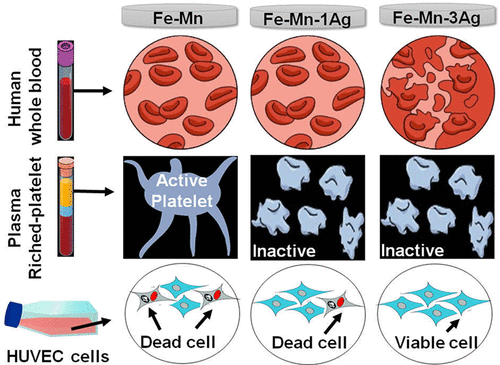当前位置:
X-MOL 学术
›
ACS Biomater. Sci. Eng.
›
论文详情
Our official English website, www.x-mol.net, welcomes your
feedback! (Note: you will need to create a separate account there.)
In Vitro Degradation, Hemocompatibility, and Cytocompatibility of Nanostructured Absorbable Fe–Mn–Ag Alloys for Biomedical Application
ACS Biomaterials Science & Engineering ( IF 5.4 ) Pub Date : 2020-03-20 , DOI: 10.1021/acsbiomaterials.0c00263 Pedram Sotoudeh Bagha 1 , Mehrdad Khakbiz 1 , Saeed Sheibani 2 , Somayeh Ebrahimi-Barough 3 , Hendra Hermawan 4
ACS Biomaterials Science & Engineering ( IF 5.4 ) Pub Date : 2020-03-20 , DOI: 10.1021/acsbiomaterials.0c00263 Pedram Sotoudeh Bagha 1 , Mehrdad Khakbiz 1 , Saeed Sheibani 2 , Somayeh Ebrahimi-Barough 3 , Hendra Hermawan 4
Affiliation

|
The addition of noble elements such as Ag was shown as a successful method to accelerate the corrosion rate of absorbable Fe-based alloys. One major concern of Ag addition is its effect on hemocompatibility and biocompatibility. In this study, in vitro degradation and surface analysis of Fe–30Mn–xAg (x = 0, 1, and 3 wt %) alloys as well as their effects on hemocompatibility and cell viability of human umbilical vein endothelial cells (HUVECs) were investigated. The static degradation rate of the alloys was 4.97, 4.69, and 4.49 mg/cm2 for Fe–30Mn, Fe–30Mn–1Ag, and Fe–30Mn–3Ag, respectively. The surface analysis after degradation showed that γ-FeOOH was formed on Fe–30Mn–3Ag, while α-FeOOH was more dominant on Fe–30Mn and Fe–30Mn–1Ag. As γ-FeOOH is more soluble than α-FeOOH, it assists further degradation of Fe–30Mn–3Ag alloy. The high amount of Ag, which induced the hemolysis ratio, however, inhibited coagulation by decreasing the platelet adhesion. Fe–30Mn–1Ag and Fe–30Mn–3Ag alloys show an improved cell viability as compared to that of Fe–Mn alloy. Shear yield strength and shear elastic modulus of the samples after immersion tests were increased, while the ultimate shear strength was not affected. On the basis of the acceptable hemolysis rate, low platelet adhesion, acceptable cell viability, and appropriate mechanical properties after degradation, Fe–30Mn–1Ag can be considered as a suitable blood-contacting Fe-based absorbable alloy.
中文翻译:

纳米结构可吸收Fe-Mn-Ag合金在生物医学中的体外降解,血液相容性和细胞相容性
已显示出添加贵金属元素(例如Ag)是提高可吸收铁基合金腐蚀速率的成功方法。Ag添加的一个主要问题是其对血液相容性和生物相容性的影响。在这项研究中,Fe–30Mn– x Ag(x = 0、1和3 wt%)合金的体外降解和表面分析以及它们对人脐静脉内皮细胞(HUVECs)的血液相容性和细胞活力的影响调查。合金的静态降解速率为4.97、4.69和4.49 mg / cm 2Fe–30Mn,Fe–30Mn–1Ag和Fe–30Mn–3Ag分别对应。降解后的表面分析表明,γ-FeOOH在Fe-30Mn-3Ag上形成,而α-FeOOH在Fe-30Mn和Fe-30Mn-1Ag上更占优势。由于γ-FeOOH比α-FeOOH更易溶,因此有助于Fe-30Mn-3Ag合金的进一步降解。但是,大量的引起溶血率的银通过降低血小板粘附而抑制了凝血。与Fe-Mn合金相比,Fe-30Mn-1Ag和Fe-30Mn-3Ag合金具有更高的细胞活力。浸泡试验后,样品的剪切屈服强度和剪切弹性模量增加,而极限剪切强度不受影响。根据可接受的溶血速率,低血小板粘附性,可接受的细胞生存力以及降解后的适当机械性能,
更新日期:2020-04-23
中文翻译:

纳米结构可吸收Fe-Mn-Ag合金在生物医学中的体外降解,血液相容性和细胞相容性
已显示出添加贵金属元素(例如Ag)是提高可吸收铁基合金腐蚀速率的成功方法。Ag添加的一个主要问题是其对血液相容性和生物相容性的影响。在这项研究中,Fe–30Mn– x Ag(x = 0、1和3 wt%)合金的体外降解和表面分析以及它们对人脐静脉内皮细胞(HUVECs)的血液相容性和细胞活力的影响调查。合金的静态降解速率为4.97、4.69和4.49 mg / cm 2Fe–30Mn,Fe–30Mn–1Ag和Fe–30Mn–3Ag分别对应。降解后的表面分析表明,γ-FeOOH在Fe-30Mn-3Ag上形成,而α-FeOOH在Fe-30Mn和Fe-30Mn-1Ag上更占优势。由于γ-FeOOH比α-FeOOH更易溶,因此有助于Fe-30Mn-3Ag合金的进一步降解。但是,大量的引起溶血率的银通过降低血小板粘附而抑制了凝血。与Fe-Mn合金相比,Fe-30Mn-1Ag和Fe-30Mn-3Ag合金具有更高的细胞活力。浸泡试验后,样品的剪切屈服强度和剪切弹性模量增加,而极限剪切强度不受影响。根据可接受的溶血速率,低血小板粘附性,可接受的细胞生存力以及降解后的适当机械性能,











































 京公网安备 11010802027423号
京公网安备 11010802027423号